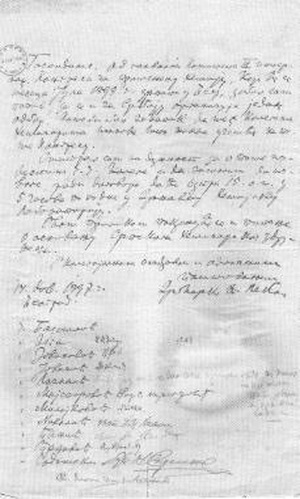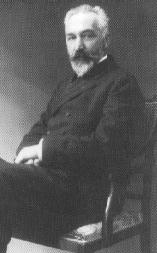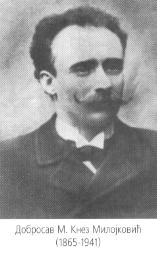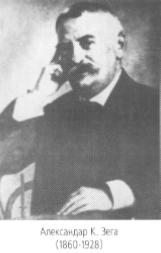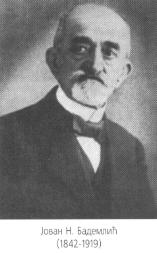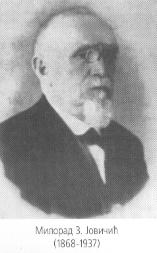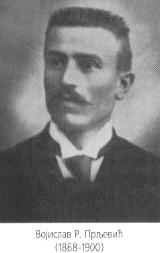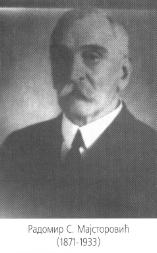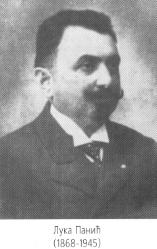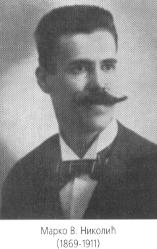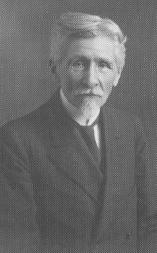О Друштву : : About SHD
A SHORT REVIEW
OF THE HISTORY OF THE SOCIETY
|
Invitation of the meeting initiating the
|
The archives of the Serbian Chemical Society were burnt in the bombing of Belgrade in 1941. But a great number of important document concerning the history of the Society were preserved and later collected from members or from Sections and Affiliates, so that, based on them, important events in the life and work of the Society, for the first fifty years, could b described after all. The reader will probably feel that the history of the Society of that time shows some blanks and that some of the descriptions are based on unreliable conclusions which are not supported by a satisfactory number of documents. The period of the next fifty years, does not have such faults. Hundred years ago, on November 15th according to the Julian calendar, that is, on November 27th according to the Gregorian calendar, 1897, in the old building of the State Chemical Laboratory (today the building of the Institute of Chemistry, Technology and Metallurgy in Njegoseva Street) in Belgrade, eleven Belgrade chemists gathered together. On the previous day, November 14th, 1897 according to the Julian calendar, that is, November 26th according, to the Gregorian calendar, they all received summons by the professor of the Velika Skola (later the University) and director of the State Chemical Laboratory, Dr. Marko T. Leko so that, as was written by his own hand in the mentioned summons, "they could raise the question of founding the Serbian Chemical Society." The immediate cause for this gathering., as can be seen from this note, was a letter sent to Prof. Leko by "The Main Committee of the III International Congress of Applied Chemistry which was to take place in Vienna in July 1898." In this letter it was suggested that a board should also be organized for Serbia with the task to incite among, colleagues as great an attendance at the Congress as possible. At this gathering entitled, as can be seen from the minutes written by Dr. Marko Nikolic, "The preliminary meeting of The Serbian Chemical Society," beside the summoner Dr. Marko T. Leko and the mentioned recorder Dr. Marko V. Nikolic, the following persons were present: |
|
Dr. Marko T. Leko |
Dr. Dobrosav M. Knez-Milojkovic |
Dr. Aleksandar K. Zega |
|
Jovan N. Bademlic |
Dr. Milorad Z. Jovicic |
Vojislav R. Prljevic |
|
Radomir S. Majstorovic |
Dr. Luka Panic |
Dr. Marko Nikolic |
|
|
Dr. Josif Sodomski, Chemist at the Commission of State Monopolies andDr. Kosta M. Jovanovic,Manager of the Mining Laboratory of the Ministry of National Economy. Summons were also sent to theSima Lozanic Professor of the Velika Skola and Minister of Economy who, at the time was away, so he could not attend the meeting. At that "preliminary meeting" Marko Leko conveyed to the attendees the request of the Central Committee of the III International Congress of Applied Chemistry "to have in Belgrade a committee formed for Serbia whose task would be to insist upon a as great as possible response to the Congress and to prepare papers for it." At the same time, M. Leko raised the question of founding a society of Serbian chemists. After the first question had been discussed for a longer time, it was principally decided "that one should accept the invitation of the Central International Committee in Vienna," and it was agreed "that they should inform the Central International Committee of having communicated it to the Society of Serbian Chemists and the Society would take up the role of the Committee for Serbia, communicating all activities to the Central International Committee." |
|
|
At the same time after a long discussion, it was decided to found an association of Serbian chemists, and only chemists, not a "chemical-physical-mineralogical society as they had tried to do some time before." Also, a principle decision was made, among others, "to begin working without any statutes, or officials (except a secretary), to fix the day of society meetings and to have the second preliminary meeting take place on December 4th, 1897." At the second meeting everybody agreed upon the following tasks of the Chemical Society 1) mutual informing in all areas of chemistry; 2) reporting about innovations in chemistry and following modem developments of science; 3) reading original papers from all areas of chemistry; 4) solving all practical chemical problems; 5) the application of chemical knowledge to the greatest extent in all fields of the national economy; 6) solving problems concerning the teaching of chemistry at our schools and 7) regulating the position of Serbian chemists. As can be seen, the Serbian Chemical Society in the very beginning took up very voluminous and serious tasks which involved dealing with all questions in the field of chemistry in our country. It is characteristic of the Society that it started to work immediately without any formalities, even without defining any official rules or naming the President of the Society, which could be seen from the previously quoted decision from the first preliminary meeting of the Society to "start work at once without any statute or officials." That is how one of the oldest scientific societies in Serbia and Europe came into life, being the tenth oldest among the chemical societies of the world. In the year when it was founded three meetings were held, and in the following year, 1898, 11 meetings were held. In the course of the following years the Society showed very lively activity, so that by 1906, 60 meetings had been held. At Society meetings, regular minutes were kept which at first were published in Nastavnik (Teacher), a magazine of the Teachers' Society. Later on these minutes ranging from the minutes of the 17th meeting held on March 27th, 1899 to that from the 60th meeting held on October 29th, 1906, were published as a special contribution to Prosvetni Glasnik (Journal of Education) under the title: The Minutes of the Serbian Chemical Society numbers 1 - 11, and printed in the State Printing House of the Kingdom of Serbia in Belgrade, so that they could be considered the first publication of the Serbian Chemical Society . |
||
- Category: О Друштву : : About SHD
- Hits: 14524
 |
The precise date when the Library of the Serbian Chemical Society was founded is very difficult to define because there is no written document about it. According to a verbal statement of Prof. A. Leko and other professors, the Library was founded on July 16th, 1934. In"The Rules of the Chemical Society of the Kingdom of Yugoslavia" from 1935, article 11 reads: "that benefactors of the Society become those who subscribe, or in their wills leave money, property, estate, books or collections worth at least five thousand dinars, if the Presidency accepts the present." This can be taken as the beginning of the library fund. The oldest seal on the books, journals and monographs bears the inscription The Library of the Chemical Society of the Kingdom of Yugoslavia, and the date on the seal is 1937. That is possibly the year when the first books were introduced into the inventory of the Library. That old inventory has unfortunately not been found, so these are only suppositions about when the Library began to exist.
Nowadays this Library is a real treasure of technical literature, either from the aspect of the historic development of chemistry in Serbia, or because of a great number of valuable and rare foreign journals. The Library has been completely organised, it has all technical catalogues (topographic, alphabetical and UDC) and one can easily find the necessary information. Gradually 740 books were registered, the largest number of which are in Serbian, some in Russian, and a small number in German, French and English.
The total fund of books was supplied either by way of exchange or received as presents from the authors or publishers. The oldest publication is from 1891, reprinted from Tezak, by Dusan M. Spasic, the author of Lectures on Hops. The oldest foreign publication is in French, a report entitled Rapport sommaire sur les relations entre le monopole de l'alcool et l'agriculture en Suisse by E.W. Miller,communicated at the Congress International d'Agriculture 1898, Lausanne. The books printed at the beginning of this century deal mostly with hygiene, agriculture, teaching and education, and have great historical significance for studying the health and hygiene situation in Serbia at the time. The most numerous books from that period are those written by Aleksa Stanojevic: Drinking-Water in Soko Banja (1908); Medical Circumstances in Serbia During the Reign of knjaz Milos Obrenovic 1815-1839; A Contribution to the Health Culture of Sremski Karlovci from 1772-1872; The Medical Situation in Zemun 1750-1900; Hamami (Turkish Public Baths) in Bosnia and Herzegovina 1462-1916; On Teaching and Education, (1913); Our Chemical Nomenclature, (1908). Worthy of attention is also The Directory of Engineers and Architects Graduating from the Technical Faculty, University of Belgrade 1919-1938. Books in the Library published later in the thirties referred mainly to the study of certain diseases in Serbia (tuberculosis, the plague), to health education, hygienic conditions and health protection of the population. After the war, at the end of 1945, article 5 of the new Rules of the Society dealt with organising a technical library. The book fund of that time contained a considerable number of books published by Nakladnl Zavod Hrvatske (the Publishing House of Croatia), such as for example, An Introduction to the Leather Industry (1947); The Technology of Resins (1947); The Dyeing and Printing of Textile Products (1948); The Beer Industry (1948); The Technology of Fuel; The Technology of Sugar; Copper; Synthetic Materials, etc. From that. time there are a lot of textbooks for secondary schools, as well as for university studies. The increase in the number of books was more than 20 books a year; later the number was reduced to 10 books a year, and nowadays decreased to 5-6 books a year. However, apart from the valuable book fund which is valuable mostly as a survey of the historical development of chemistry in Serbia, the Library of the Serbian Chemical Society has a very rich fund of journals from all over the world, from China, Japan, India, the Soviet Union, Romania, Bulgaria, Greece, France, England and North and South America. All these journals are in the possession of the Library of the Serbian Chemical Society, and it is impossible to find them in any other library in Yugoslavia. This fact makes the importance of these journals greater. The journal inventory comprises 1440 bibliographic units, and there are 217 titles of foreign journals and 72 titles of domestic periodicals, that is, 22000 issues of journals.
The oldest foreign journal the Library has is from 1911, the Journal of the American Chemical Society, and the oldest domestic one from 1927, the Archives for Chemistry and Pharmacy. A larger number of journals were received after 1950, but the Library was given the most journals in the seventies. At the time, through exchange, more than 70 titles of journals come to the Library from all parts of the world. After this period the number of journals mainly constantly decreased: in the eighties 60 titles, in 1991- 44 titles, in 1992 - 24 titles, in 1993 - 19 titles, in 1994 - 25 titles, and in 1995 29 titles. The Library was given journals even before the Second World War, but during the war years there was a break and the material that had been received was mostly destroyed in bombings, and many books were taken out of the country without permission, as in the case of the Library of the Faculty of Technology in Belgrade.
Apart from all this, the Library of the Serbian Chemical Society has managed to preserve the following important journals, some of which date back to the first year of publication, which represents a special value:
Abstracts of Bioanalytical Technology (from Vol. 1, 1953);
Bulletin of the Chemical Society of Japan (11, 1936);
Bulletin de l'Academie Polonaise des Sciences (1, 1953);
Chemicke Zvestl (8, 1954);
Collection of Czechoslovak Chemical Communications (1, 1929);
Godisnik na Hemiko-Technologiceskia Institut (1, 1954);
Hungarian Journal of Industrial Chemistry (1, 1973);
Indonesian Abstracts (1, 1958);
Industria i Quimica (Buenos Aires) (1, 1935);
Journal of Antibiotics (10, 1957);
Journal of the Indian Chemical Society (8, 193 1);
Journal of the Research Institute for Catalysis (4, 1956);
Memoirs of the Faculty of Science (1, 1949-1950);
Pakistan Journal of Science (9, 1957);
Periodica Polytechnica (1, 1957);
Journal of the Hindi Science Academy (1, 1958);
Revista Technologica-Habana (1, 1963);
Science Reports of the Research Institute of the Tohoku University (1, 1949);
Scientific Papers of the College of General Education University of Tokyo (1, 1951);
Vesnik Leningradskogo Universiteta (1956); Zurnal Neorganiceskoj Himii (7, 1962) etc.
It can be seen from the list that the Serbian Chemical Society has a modest (due to the circumstances in our country), but a valuable library.
However, a point of worry is the constant decrease in the annual income of books and journals, which has been particularly emphasised in recent years. At the beginning of the second hundred years of its existence, the Society has to face a difficult task - to renew the times when the increase was greater.
Running sneakers | Sneakers Nike Shoes- Category: О Друштву : : About SHD
- Hits: 20930
Karnegijeva 4/III, PAK 135804, 11 120 Belgrade, P.O.B. 36, Serbia
tel./fax (+381 11) 3370 467; E-mail: This email address is being protected from spambots. You need JavaScript enabled to view it.
Journal of the Serbian Chemical Society
Karnegijeva 4, PAK 135804, 11 120 Belgrade, P.O.B. 36, Serbia
tel./fax (+381 11) 3303 731; E-mail: This email address is being protected from spambots. You need JavaScript enabled to view it.
Хемијски преглед
Уредништво: Хемијски факултет , Студентски трг 16, соба 424, I спрат
tel./fax (+381 11) 3282 630; E-mail: This email address is being protected from spambots. You need JavaScript enabled to view it.
best Running shoes brand | Nike Releases, Launch Links & Raffles
- Category: О Друштву : : About SHD
- Hits: 183486

